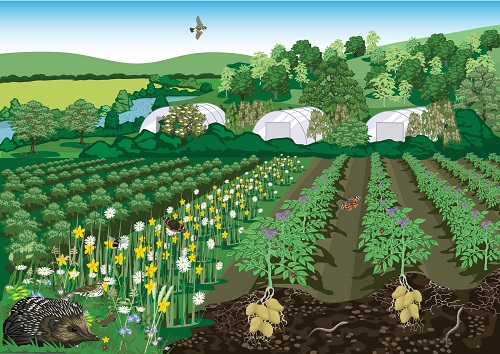HORTICULTURE
Here are some practical ways to take climate action and enhance biodiversity on your horticulture farm
Climate & Biodiversity actions full doc (pdf)
Horticulture section only (pdf)
“We look at the farm as a place which doesn’t just produce something to be sold somewhere else but also as a place we can rely on to meet more of our needs – fuel, materials, food year round and a pleasant place to spend time. Giving space to those other needs means more space for nature, more varied habitats and greater autonomy to us on the ground.” Fergal Anderson, Horticulturalist & FFN Ambassador, Co. Galway.
1. Soil
“soil health is key (.) I am all the time building organic matter and hopefully carbon storage in the soil. Using minimum tillage, slow tilling, and avoiding prolonged bare soil periods is imperative … cover crops and green manure crops are a must … (they) build soil health (and) diversity, whilst (also) increasing insect and bird life on your holding.” Jim Cronin, Horticulturalist & FFN Ambassador, Co. Clare.
Healthy soils store carbon
- Compost your vegetative waste!! – check out online videos to learn how to make the most nutrient dense compost fertiliser
- Increase organic material by adding compost, farmyard manure and crop residues to your soil
- Choose min-till and direct drilling over inversion ploughing
- Diversity is key to soil health; experiment with catch, combi, cover, and double-cover crops in your rotations
- Maintain aerated soils by avoiding compaction from increasingly heavy farm machinery
- Consider cultivating in spring rather than autumn
- Get to know your soil and see what it looks like under the surface – don’t just soil test, dig some holes and have a look!!
- Keep soil covered – exposed soils are degraded soils
- Try biostimulants and nature-friendly inoculants e.g. vermi-liquid or compost fertiliser instead of chemical seed and soil treatments
- A single cubic inch of soil can contain eight miles of mycelia – naturally occurring fungal hyphae that boost soil fertility. Allow these engines of growth to work for you by avoiding fungicides where possible
- Be curious! Discover more about your own soil by exploring apps and online resources
- Experiment with soil building techniques from regenerative farming, permaculture, organic farming, or Korean Natural Farming
“make quality compost, it recycles organic materials and it makes your holding “hum” with life.” Jim Cronin, Horticulturalist & FFN Ambassador, Co. Clare.
Co-benefits for farmers
Healthy soil:
- increases yields
- has a higher level of available nutrients for crops (meaning less fertilizer is used)
- is easier to cultivate (meaning less diesel is used)
- retains more moisture (making crops more drought tolerant)
- drains better (making land more flood resistant)
- supports more soil microbes (which in turn store more carbon and lead to even healthier soils).
“The no dig beds … (have) allowed me to plant vegetables and walk away and have very little time weeding. No cultivation whatsoever and very healthy crops.” Fergal Smith, Mixed stock farmer & FFN Ambassador, Co. Clare.
2. Trees, scrub & hedgerows
Woody vegetation captures carbon.
- Allow natural regeneration of trees and scrub in less productive areas or difficult corners
- Plant diverse native hedgerows
- Allow existing hedgerows to grow tall and wide
- Diversify farm enterprises by planting a native woodland
- Try agroforestry/silvopasture
- Retain existing hedgerows, woodland, copses and scrub
Co-benefits for farmers
- shelter-belts for crops
- diverse cropping
- habitat for pollinators and beneficial predatory insects
- better-connected and richer wildlife habitats
- improved drainage and soil and water quality
- reduced soil erosion
3. Nutrient management
The manufacture of chemical fertilisers generates ~1.4% of all carbon dioxide emissions. Furthermore, the application of fertilisers releases nitrous oxide, a gas with 300 times the global warming potential of carbon dioxide. Reduce use by increasing efficiency:
- Permaculture, organic farming and Korean Natural Farming all offer solutions in terms of maximizing production in horticulture whilst minimizing chemical inputs
- Maximise nutrient uptake by crops by maintaining optimum soil pH
- Choose crops that require fewer chemical treatments and are naturally resilient to climate change (e.g. more extreme droughts, floods or winds)
- Build fertility using catch crops, cover crops and green manures
- Spread fertiliser on warmer days (soil temp at least 6°C) to maximise absorption
- Include nitrogen fixing legumes in your crop rotations (e.g. peas, vetch, beans)
- Try simple mobile phone operated GPSs and tractor sensors to maximise nutrient uptake through targeted spreading
- Explore alternatives to chemical fertilisers (e.g. compost, organic manures)
Co-benefits for farmers
- Decreased fertiliser use (lower costs)
- Increased farm self-sufficiency (lower external inputs)
- Improved long-term soil fertility (increased yields and climate resilience)
- Greater resilience to shifts in market forces (less reliance on expensive external inputs) and to extreme weather events (e.g. droughts and floods)
“MycoFarming is not just about rediscovering the wonders of mushrooms for our farms and environment. It is about improving our understanding of their role in the natural world …
If we want to build more resilient, sustainable and climate-proofed farms we need to drastically reduce our chemical and oil based inputs. Replacing them with nutrients and minerals released from our existing bedrocks and soils by the expertise of a hundred million years of evolution.” Thomas & Claire O’Connor, Horticulturalists & FFN Ambassadors, Co. Kerry
4. Water management
Our water bodies (rivers, lakes and oceans) naturally work together to support biodiversity and to store carbon. When water bodies are polluted, these systems break down. Almost half of Irish surface waters are not in good health and the situation is deteriorating. Help to restore our water bodies by eliminating harmful farm run-off:
- Minimise water use – harvest rainwater and choose drought resistant plant varieties
- Regularly update and repair irrigation systems
- Treat your chemicals with respect – just one drop of pesticide can pollute a small stream for over 30kms!!
- Boost populations of predatory insects (and reduce the need for pesticides) by creating or enhancing hedgerows and field margins – these will move onto the crop in spring, naturally reducing the pest burden
- Reduce herbicide use by using alternative methods of weed control e.g. non-synthetic herbicides and diverse crop rotations. As many synthetic herbicides are water soluble (e.g. MCPA, 2,4-D), it is almost impossible to ensure they do not end up in watercourses after application!
- Reduce run-off from fields by slowing the flow of surface water: plant buffer strips, field margins and native hedgerows; never spread or spray when rain is due.
- List the potential sources of run-off from your farm and how you might eliminate them. Some of these (e.g. herbicides, pesticides, fungicides) are more obvious than others (e.g. spoil from tractor tyres, washings or sediment from soil erosion).
- Reduce herbicide use by using alternative methods of weed control e.g. non-synthetic herbicides, mulching and diverse crop rotations
- Eliminate costly waste – use fertilizers, herbicides, pesticides, fungicides, molluscicides and chemical seed treatments only where needed
- Every drop counts! – treat any spray residue from washings, tanks and storage containers with respect
Co-benefits for farmers
- Reduced input, labour, fuel and machinery costs
- Cleaner water – research has detected herbicides in 38% of drinking water wells tested in Ireland!
- A healthier working environment for the farmer, the farm family, the local community and for future generations!
5. Energy & fuel
Maximising energy efficiency and moving away from fossil fuels are two ways in which horticultural systems can minimise their carbon footprint.
- Consider using solar water pumps – the technology and cost has greatly improved in recent years
- Heat pumps can be a good alternative to fossil fuel based heating systems
- Turn it off when not in use! Lights, fridges, freezers, fans, heaters, computers etc. all contribute to the farm carbon footprint
- Drinking water production and supply requires energy, yet >43% of treated drinking water in Ireland is lost to leaks. Fix leaks!
- Consider renewable energy – is there a roof that could support solar panels?
- Minimise chemical fertilisers, herbicides and pesticides – these are all manufactured using fossil fuels
- Take care when opting for ‘degradable plastics’ – many products will leave plastic residues in your soil
- Cut down route-to-market costs by selling direct to consumer and transport emissions by selling locally
- Minimise food waste and make sure to compost any vegetative waste – it’s a valuable resource!
- Harvest water from buildings – using this ‘grey water’ to grow crops can save money and energy
- Use machinery (diesel!) efficiently – check tyre pressure regularly and remove unnecessary tractor weights
- Plastics are produced using fossil fuels – avoid suppliers that use excessive packaging
Co-benefits for farmers
- Reduced fuel and input costs
- Reduced energy costs
- Improved farm self-sufficiency and climate resilience
- Increased opportunities for marketing sustainable produce
“I focus on selling my vegetables within a ten mile radius of the farm, which reduces fossil fuel use” Jim Cronin, Horticulturalist & FFN Ambassador, Co. Clare.
Curious? Have you run the numbers?
Going organic: Have you run the numbers for going partly or fully organic? New supports and a growing market are making this an increasingly attractive option for certain sectors in horticulture.
Not ready to go fully organic? Try some small-scale experiments using organic methods to reduce chemical inputs, or with techniques from permaculture, agroforestry, regenerative farming or Korean Natural Farming.
Nature co-benefits
Climate action on horticultural holdings can benefit nature by creating:
- More species-rich and diverse landscapes, supporting native fungi, insects, birds, mammals and more!
- Healthier rivers, lakes, estuaries and oceans, rich with life
- Habitat for our native species to feed and breed
- Nature-rich farms – loud with humming insects and singing birds
- A model for other farmers; when we experience nature on another farm we are more likely to want to protect it on our own!
Nothing beats nature for providing natural climate change adaptation and mitigation. Boosting biodiversity, from the soil to the treetops, will help your farming system to remain productive and resilient in the face of increasingly unpredictable weather events. In horticulture in particular, rough grassland, fallow plots, beetle banks, hedgerows etc. provide habitat for pollinators and predatory insects. Pollinating insects can substantially boost yields whilst predatory insects can provide natural controls for crop pests, allowing you to reduce pesticide use.

Please view the other farming sectors here

